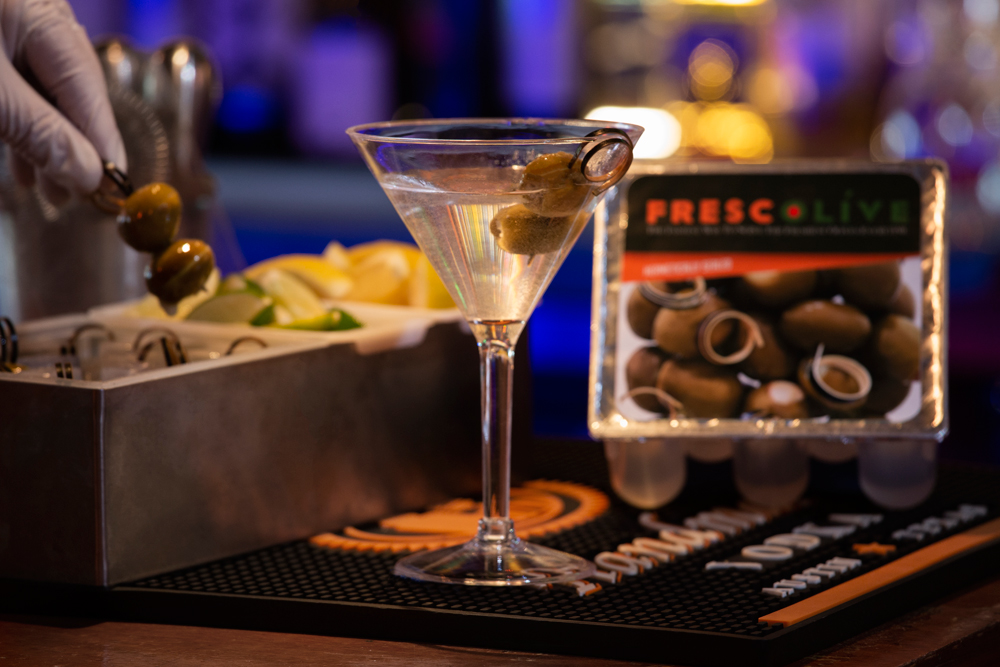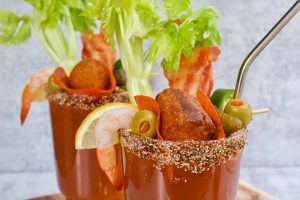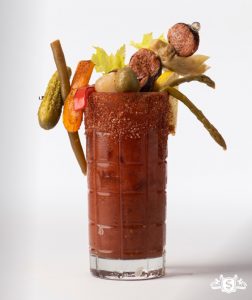The saying goes that you eat and drink with your eyes first, and that’s just one reason why the right garnishes are so important when crafting a cocktail.
“I think it completely dresses up any cocktail and just makes it a lot more attractive,” says Mark Traaseth, national sales manager at Stone Gate Foods, which makes Tater Kegs. “People like to look at a drink and see the elegance of it.”
Kevin O’Brien, president/owner of Frescolive—a maker of fresh, ready-to-serve olives for garnishing—sees garnishes as playing a supporting role. “The garnish is the character actor to a cocktail. It has to be subtle, yet add to the leading booze in the cocktail,” he says. “Taste and color are all very important characters of a supporting role in all cocktails.”

Katherine Foley, brand manager at Infinium Spirits, a family-owned spirits company including brands like Seagram’s Vodka, believes garnishes can add both taste and color to a cocktail. “As the final touch and usually the last step in the method of crafting a cocktail, a garnish plays two roles: adding color and a decorative visual to the drink, as well as enhancing flavor,” she says. “That said, the importance of a garnish is to evolve the look of the drink and make it more visually appealing to the consumer by adding a premium and craft-like element. Additionally, depending on the type of garnish, the flavor it adds to the cocktail can enhance and complement the recipe’s other ingredients. A garnish can also simply add flavor to more standard cocktails such as vodka sodas.”
Foley says wedges of fruit are the most common garnish, like lime, lemon, or orange wheels. “The added citrus from the lime/lemon can help balance out sweeter notes or bitter notes in the case of a vodka tonic,” she says. “It can also add more flavor to more straightforward cocktails, such as vodka sodas, as mentioned prior.”
Aside from citrus wedges and wheels, Foley says not to discount the power of mint. “I will always recommend mint as the best garnish for a variety of cocktails,” she says. “I even started adding mint to my margaritas and lemon drop martinis! For most standard vodka cocktails, mint can add a new spin of flavor to a recipe that doesn’t normally include it but adds a cool and refreshing taste that becomes present in the drink.”
While fruit wedges and mint leaves represent the simpler end of the spectrum, what’s been trending lately has been a move toward over-the-top garnish options.
“People seem to respond well to new and innovative ways of enjoying a classic cocktail,” says Foley. “Over-the-top garnishes can bring new elements to life in these fixtures. There is even more experimentation with crafting cocktails with new spirit categories, such as a tequila Old Fashioned versus the classic whiskey spirit. This reflects in standard cocktails as well, such as the classic Bloody Mary. We have created several signature Bloody Mary recipes for our Seagram’s Vodka that have different sets of over-the-top garnishes, each adding different types of flavor components to the drink—whether it’s heaps of meats to add more substance, maple butter to add more sweetness, or even green-based vegetable garnishes to make it more herbal.”
Traaseth views the over-the-top trend as a way for establishments to set themselves apart. He also says there are good margins to be made by charging more for these extravagant cocktails. “You can look at the margins that you can make on a cocktail by dressing it up. I have actually paid $30 for a Bloody Mary before. It was called The Tacklebox, and it had a little bit of everything on there—you had a meal in itself,” he says. “Really, the cost of it would have been more if I had appetizers and a drink.”

In fact, when it comes to choosing garnish ingredients, Traaseth says it can be beneficial to use items that are on your appetizer menu so that it offers guests the option to order a full appetizer if they like the sampling on their cocktail. He says Tater Kegs, which are jumbo stuffed tater tots available in a variety of flavors, are especially well suited to this tactic.
Traaseth says Tater Kegs work great as garnishes on a Bloody Mary. “They give you the sense of being more satisfied when you do have a Bloody Mary. Ours have the seasoning in it that really adds to the cocktail,” he says. “We have the Buffalo Chicken Tater Keg that works really good on top of a Bloody Mary. And the other one that works really well with it is our Crab Feast so you get the seafood in with it. You can put one or two of these on top of a Bloody Mary, and you can get an extra couple bucks for your cocktail.”
He also recommends pairing them with smoky cocktails, “Our Chorizo Burrito Tater Keg goes really well with an old fashioned or a smoky old fashioned.”

While garnishes work well on cocktails for guests dining in (or outside), COVID-19 has led to a whole new to-go cocktail market for many bars and restaurants. Foley says while garnishes may not be able to play a role in the presentation of to-go cocktails, they can still be included when packaging up a drink. “They do have a place in takeout drinks. Some will slice up the garnishes and tie up a couple of pieces in a small baggy that comes with the drink on the side,” says Foley. “For example, many Mexican restaurants will do this for margaritas and incorporate a couple of lime wedges in a bag or small container.”
COVID-19 has also necessitated a sharper focus on cleanliness and sanitation, and the handling of garnishes is something bars should be considering. First and foremost, hand washing is a must before handling. “I would recommend, of course, washing your hands thoroughly before handling the garnishes,” says Foley. “For fruit, I always thoroughly rinse it under water before cutting.”
Aside from this, the general rule is the less handling the better. “The nice part about a Tater Keg is it goes right from your freezer to your fryer to your cocktail or to your plate. So there’s not a lot of handling with the product at all,” says Traaseth. “You can have it cooked, you can have it sitting in a warmer, and be able to take it right out and put it right on the cocktail without a lot of touching.”
Even before the pandemic, O’Brien had cleanliness on his mind when he created Frescolive as a sanitary alternative to digging olives out of a jar. “We package our olives in a food incubator to ensure all health department regulations are met. The unit is hermetically sealed to ensure the sanitation practice used during packing will last until the time you unseal it to be used,” he says. “Once unsealed, the olives sit in pods in their brine already skewered. The bartenders/servers grab the top of the skewers and attach it to the side of the drink—a totally hygienic way of serving.”
In addition to a more sanitary process, Frescolive also cuts down on waste and dried-up olives as well as enables servers to add olives to a cocktail much more quickly.
By Ashley Bray








